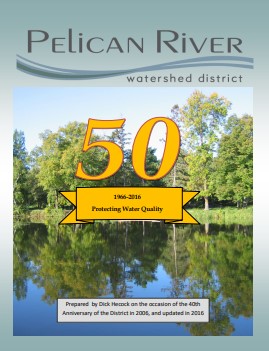Please Note: Prepared by Dick Hecock on the occasion of the 40th Anniversary of the District in 2006, and updated in 2016.
For hundreds of years prior to the arrival of Europeans, various native tribes established scattered villages in the vicinity of the Pelican Chain of Lakes. In the 1700 and 1800’s population was still sparse, and there was very little disturbance of natural systems. With permanent European settlements arriving in the 1870’s, logging and agriculture began. By 1900 the area that would become the Pelican River Watershed District had experienced significant deforestation. Lakes had been dammed and rivers straightened for the Pelican River Navigation System, which was responsible for stimulating a tourist industry based upon summer cottages and resorts. With the arrival of the automobile, the tourist business exploded, so that the area’s population reached 5000 by 1920. At about the same time, major ditching to enhance agriculture caused further and quite profound changes to the lakes, streams and wetlands.
Local awareness of lake water problems began in the late 1940’s as lake use intensity and shoreline densities increased. In the 1950’s and 1960’s, as the area’s population reached 9500, instances of algae blooms and nuisance weed growth began to interfere with recreational use of lakes. There was growing suspicion that inadequate sewage treatment were major culprits. Desperate lake dwellers formed lake associations, started lawsuits, and experimented with chemicals to treat the symptoms of lake deterioration. Business leaders, as well as city and county officials, feared negative impacts on lake-oriented tourism.
In 1965, both the Melissa and Sallie Improvement Association and the Lake Detroiters, advocated for a governmental unit that would be able to address lake problems. Dr. Tom Rogstad, President of Lake Detroiters, led a delegation, including Attorney Robert Irvine and Detroit Lakes City Engineer Winston Larson, to St. Paul to seek enabling legislation that would make it possible to create a local government unit for purposes of “finding causes and solutions for lake eutrophication problems”. They brought a draft bill to Senator Norman Walz of Detroit Lakes, but soon learned that a watershed district created under the auspices of the State’s 1955 Watershed Act, would serve the purpose if that Act was slightly amended to allow lakes and the lands that drained to them, to be defined as a watershed. The necessary amendments were enacted, and the PRWD was the first watershed district to organize under the amended law.
On September 15, 1965 a copy of a petition asking for the creation of the Pelican River Watershed District was filed with the Minnesota Water Resources Board. The petitioners, seeking to slow down the eutrophication of the lakes, among other purposes, were the Becker County Commissioners. After public meetings and discussion where local officials and the business community offered strong support, the petition was amended slightly and submitted by both the Becker and Otter Tail County Commissioners.
The proposed boundaries of the District were subsequently reviewed in detail and modified by the Director of the Division of Waters. This process was based upon existing maps and detailed field surveys in the fall of 1965 and winter of 1966. The Director considered several lakes included in the original petition as having doubtful surface water links to the main chain of lakes; these included Spear, Pearl and Loon lakes, west of Lake Sallie, and Wine, Brandy, and several others lying west of highway 59 and North of Highway 10. On the other hand, the Director recommended inclusion of those lakes, as well as Mill Lake and Buck’s Mills Dam, and some additional tributaries to Lake Melissa and Mill Lake, including some in Otter Tail County.
![]() Read the whole PRWD - 50 Year Booklet
Read the whole PRWD - 50 Year Booklet
